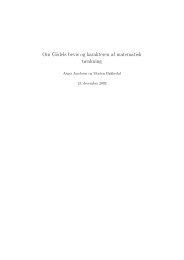Master Dissertation
Master Dissertation
Master Dissertation
You also want an ePaper? Increase the reach of your titles
YUMPU automatically turns print PDFs into web optimized ePapers that Google loves.
Definition 2.2. Given some point x the forward cone of x is defined by<br />
and the backwards cone of x is<br />
V + (x) = {y|(y − x) 2 ≥ 0 and y 0 ≥ x 0 },<br />
V − (x) = {y|(y − x) 2 ≥ 0 and y 0 ≤ x 0 }.<br />
The n-dimensional generalizations are<br />
Γ ± n (x) = {(x1, . . . , xn)|xj ∈ V ± (x) and ∀j = 1 = 1, . . . , n}.<br />
That (y − x) 2 ≥ 0 just means that they have to be causally connected.<br />
Later we will need a symbol to distinguish points in time.<br />
Definition 2.3. Let A, B ⊂ M. If for all x ∈ A and y ∈ B we have<br />
x 0 < y 0 , we write A < B.<br />
2.2 The Poincaré Group<br />
Definition 2.4. Let Λ ∈ L and a ∈ R 4 . By a Poincaré transformation<br />
Π : R 4 → R 4 we mean Π(x) = Λx + a, and we write Π = (a, Λ).<br />
The set P of all Poincaré transformations form a group under the<br />
composition law<br />
(a1, Λ1)(a2, Λ2) = (a1 + Λ1a2, Λ1Λ2).<br />
We see that the Poincaré Group P is the semidirect product of L and the<br />
group of space-time translations (R 4 , +), that is<br />
P = R 4 ⊙ L<br />
Further we define the Proper Poincaré Group as<br />
P ↑<br />
+ = R4 ⊙ L ↑<br />
+<br />
16



